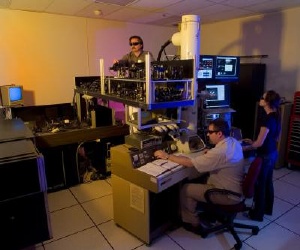May 13 2009
A proposal by a team of UC Davis scientists to develop the world's first electron microscope capable of filming live biological processes has been awarded a $2 million grant from the National Institutes of Health.
 The dynamic transmission electron microscope at Lawrence Livermore National Laboratory. Credit: Lawrence Livermore National Laboratory
The dynamic transmission electron microscope at Lawrence Livermore National Laboratory. Credit: Lawrence Livermore National Laboratory
The team's plan is to extend the capabilities of a powerful new imaging tool called the dynamic transmission electron microscope or DTEM. These instruments can snap 10 to 100 images per millionth of a second, while capturing details as small as 10 nanometers, or about four times the diameter of a DNA molecule.
If they can be adapted to living, moving systems, DTEMs could achieve resolutions 100 times greater than currently attainable for live processes, enabling scientists to observe and record biological processes at the molecular level.
"A microscope with these capabilities will allow us to make milestone advances in our understanding of diseases like cancer, bacterial or viral infections, and basic biological processes," said the research team's leader, Nigel Browning, a professor of chemical engineering and materials science at UC Davis and a staff scientist at Lawrence Livermore National Laboratory. The instrument he and his colleagues propose to design and build would be capable of attaining resolutions as low as one or two nanometers.
Currently, there are only three DTEMs in use worldwide, none of which are designed for observing living systems. Rather, they are utilized to document such processes as inorganic chemical reactions and the dynamics of materials as they change from one state — solid, liquid or gas — to another. Browning led the group that developed a DTEM in use at Lawrence Livermore.
DTEMs are advanced versions of transmission electron microscopes (TEMs), which have graced research facilities since the late 1930s. However, rather than taking static photos like their predecessors, DTEMs capture processes in real time by using a pulsed laser to produce very short bursts of electrons to illuminate specimens.
In order to create the third-generation TEM, which Browning and his team are calling a "Bio-DTEM," three new elements must be incorporated into the design: a custom-built system to hold an ultra-thin layer of fluid containing the biological sample to be imaged; a short-exposure-time imaging mode, to avoid the blurring problem created when molecules move through their fluid medium; and a new generation of scientific instrumentation to deliver optimum image contrast for biological samples and to correct image distortions generated by lenses.
"It should be noted that each of the components of our proposed new system are commercially available," said Browning. "Our work will be to bring them all together into a single instrument. With this grant from the NIH, I'm confident that we will be able to do so."
Five UC Davis colleagues will collaborate with Browning on the project: Peter Armstrong, Jodi Nunnari and Jon Scholey, professors of molecular and cellular biology; Wolf Heyer, professor of microbiology; and Stephen Kowalczykowski, distinguished professor of microbiology. In July, Browning will add an appointment in the Department of Molecular and Cellular Biology to his academic positions at UC Davis.